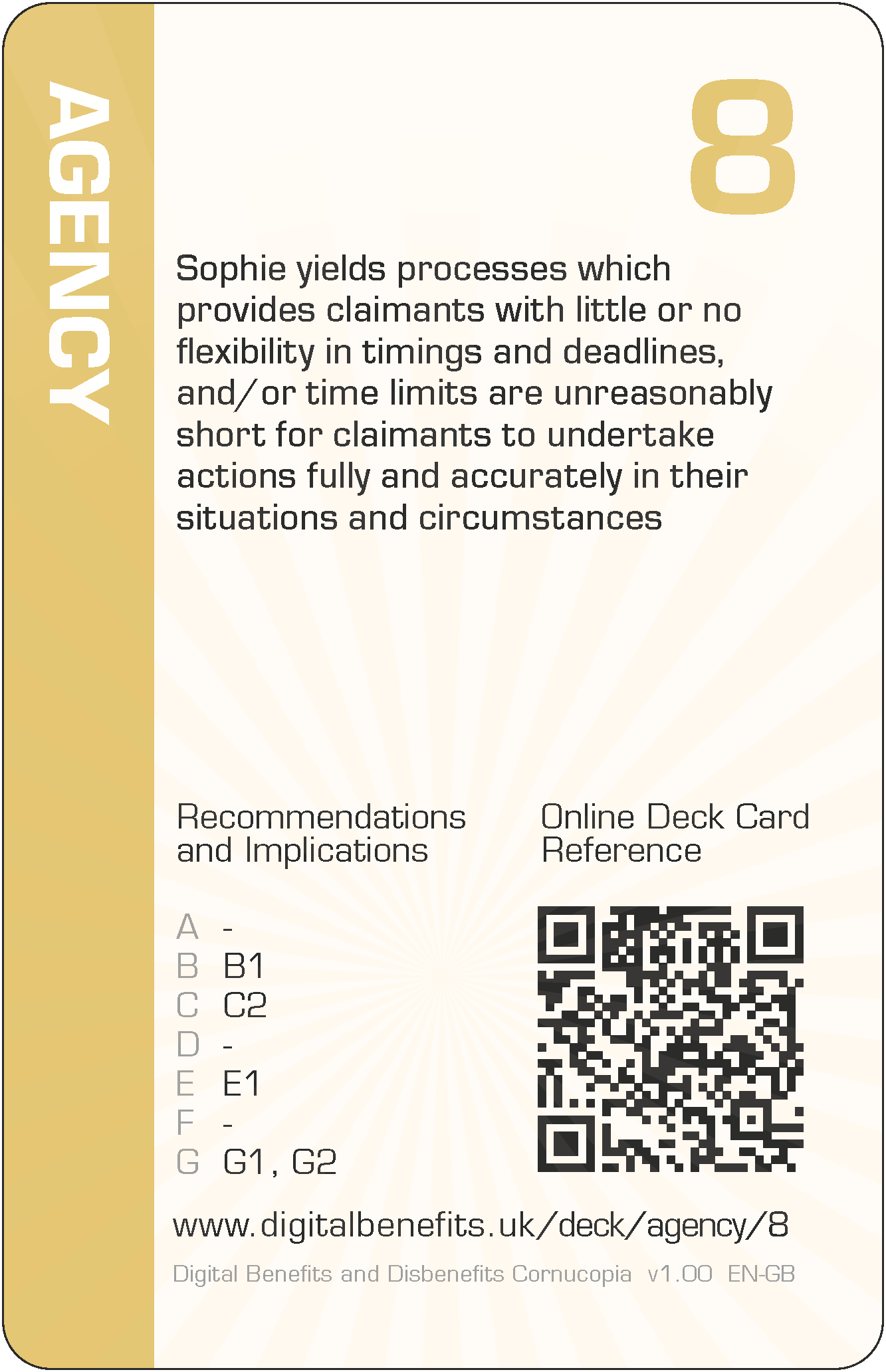Agency 8 (AG-8) Card
DBD Cornucopia > Deck > Agency > 8
Card Details - Eight of Agency
Abbreviation
AG-8
Card's focus
The focus of this card is durations and deadlines
Threat to claimants
Sophie yields processes which provides claimants with little or no flexibility in timings and deadlines, and/or time limits are unreasonably short for claimants to undertake actions fully and accurately in their situations and circumstances

Threat to claimants
Sophie yields processes which provides claimants with little or no flexibility in timings and deadlines, and/or time limits are unreasonably short for claimants to undertake actions fully and accurately in their situations and circumstances.
Some examples of how this threat could lead to harms (negative effects on claimants)
The design recommendations and implications relevant to the card are listed below in the next section, but even those can be somewhat abstract and difficult to think about during practical day-to-day implementation. Therefore, some example harms are provided to complement the more formal research outputs. These examples are unique per card, and are only published on these web pages (i.e. in no other project outputs).
- Claimants cannot get professional advice within the time limit enforced, adversely affecting making an accurate and full claim
- Claimants fail to complete a mandatory task in time because of urgent care responsibilities, and are penalised
- Claimants are not given long enough, so do not reply to notifications in time, because their phone was damaged or they had no money to buy another quickly
- Postal delays are not properly taken into account, reducing the available time for claimants who use paper communication methods, thus making them less likely to respond, or to respond but with poorer information
The examples are to help understand the threat on the card, not to suppress thinking and innovation. Incorporating these examples exactly, or closely matching ones, should be scored down when playing DBD Cornucopia as a game.
Applicable design recommendations and implications
These are reproduced here from Research Briefing N
Acknowledge claimants as people in digital design
- Prioritise claimants' interests over system efficiencies
All digital welfare design processes, methods and decision-making should prioritise claimants' needs to achieve best outcomes for individuals rather than system efficiencies. Organisational knowledge and resources should be utilised to this respect including intervening in advance to identify matters that affect claims or what claimants may have forgotten about.
Reduce claimants’ interaction burdens with digital welfare
- Provide greater flexibility and accommodations for claimants in the accuracy, precision, timeliness and permanence of the remaining information they provide
Design for people's lives which can be complex and where changing events and circumstances, often beyond their control, drive their need and eligibility for social protection payments. Allow adequate, rather than complete and precise, data that suffice for the state's needs. Increase flexibility of use by avoiding strict deadlines; limiting the use of actions that block progression; permitting correcting, updating and reversing information; and withdraw penalties for simple slips and lapses.
Design systems which support the division of labour with claimants' ecosystems
- Integrate accurate specific and contextual primary guidance about making claims within systems and promote secondary professional assistance
None
Signpost when additional assistance should be sought and recognise the time and effort needed to complete these activities
- Indicate to claimants when professional advice is crucial
Some activities undertaken to receive a social protection payment award require much more specialist knowledge and experience than most citizens have; such involvement can counter complexity to avoid becoming overwhelmed; increase visibility of when claimants should check whether advice can help by highlighting higher-risk parts of the process; avoid overly simplifying processes which can hide the underlying and necessary complexity of making and maintaining a claim and thus discourage seeking knowledge and experience in the wider ecosystem. - Reduce barriers for claimants to seek assistance and allow time for this to occur
Provide pointers to claimants where they can obtain independent professional help ensuring there is always a choice of communication channels and sources, whether by self-service or from elsewhere in ecosystems. Avoid deadlines which limit claimants' opportunities to access assistance, providing sufficiently long periods for activities to include these actions if required.
General Notes
Card values (i.e. '8' for this card) are for game play and are not correlated with the severity of harm. This is because threats cannot be ranked directly since they can affect individuals in different ways due to situations and circumstances, or affect fewer or more claimants, or the harms can arise in claimants' support networks and wider society.
The threat description uses a person's name as the "attacker" (i.e. 'Sophie' for this card), which can be thought of someone involved with implementation. They could have any role which influence digitisation. So they could be a database administrator, or a copy writer, or a quality assurance specialist, etc, or all of these. Everyone could have some influence on the claimant threat described. The names were randomly selected from those currently most popular as given names for boys and girls (UK Office for National Statistics).
The example harms provided are drawn from the research data (which explored not only parts of existing services but also the effects of possible changes to those), from the author's own knowledge of web application development and testing, the author's own experience of helping citizens to claim Universal Credit (UC) and Personal Independence Payment (PIP), and from suggestions submitted by other people (make a suggestion). The threats and example harms do not necessarily exist in the current UC or PIP deployments or in ecosystems around those services, but they might well do.
All the cards in this Agency suit are: 2 3 4 5 6 7 8 9 10 J Q K A
The other suits in the deck are: Scope, Architecture, Trust, Porosity and Cornucopia (plus Jokers).
